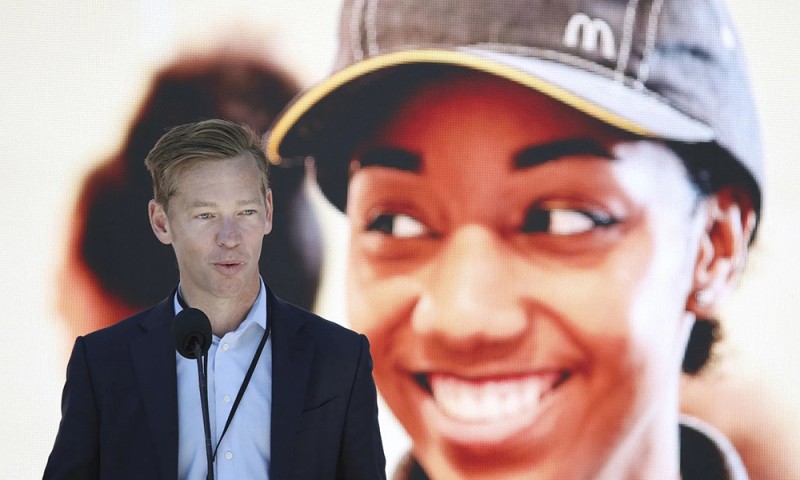
如果一家餐饮巨头的首席执行官不吃自家公司的产品,那会显得很奇怪。不过,这对麦当劳的掌门人来说完全不是问题。
首席执行官克里斯·坎普钦斯基(Chris Kempczinski)近日在社交媒体上发帖称,自己经常被问到一个问题:他有多频繁地光顾这家标志性的快餐连锁店。
“实话实说,频率很高,大概一周三到四次,”他表示,“有时是吃早餐,有时是吃午餐。不过,嘿,这也是工作的福利之一——你可以经常吃麦当劳。”
这似乎是职位带来的常态,其他餐饮业的首席执行官们也分享过他们在自家餐厅的用餐习惯。
在出任星巴克首席执行官之前,倪睿安(Brian Niccol)曾透露,他在奇波特尔的必点菜品是鸡肉卷饼碗,内含白米饭、法西塔蔬菜、番茄莎莎酱和“少许”奶酪。除此之外,他还会点一份芭芭可亚肉墨西哥馅饼,当然也少不了玉米片配鳄梨酱。
“就我的年龄而言,这些食物可能有点过量了,”倪睿安去年接受《财富》(Fortune)采访时坦言,“但你知道,实在难以抗拒。”
红龙虾(Red Lobster)的首席执行官达莫拉·阿达莫雷肯(Damola Adamolekun)也曾分享他在自家海鲜连锁店最喜爱的菜品。过去他最爱的是雪蟹,但现在换成了另一种螃蟹。
“我最近尝试了北蟹,它是雪蟹的一个品种,现在成了我的新宠,”他去年告诉《华尔街日报》(Wall Street Journal)。
据红龙虾介绍,北蟹腿是野生捕捞的,“直接来自白令海的冰冷水域”,比雪蟹腿肉质更饱满,味道更甜美。
与此同时,坎普钦斯基正带领公司在复杂的餐饮市场环境中前行:通胀持续高企,而顾客依然期望在麦当劳获得价格实惠的食物。
今年早些时候,在顾客抱怨套餐价格过高后,公司下调了套餐价格。
坎普钦斯基承认了这个问题,他在一次财报电话会议上表示:“当你看到套餐价格超过10美元时,这绝对会对价值认知产生负面影响。”
他还指出,消费者群体也日益分化。他上月告诉美国消费者新闻与商业频道(CNBC),低收入顾客正在削减开支,他们不再将快餐视为日常便利之选,而更像是一种偶尔的奢侈享受。
“尤其是中低收入消费者,他们现在感到压力很大,”他补充道,“周围有很多议论,‘经济状况到底如何?现在怎么样?’我们看到的情况是,这确实像是一种两极分化的经济。如果你是高收入者,年收入超过10万美元,情况还不错……但我们看到的中低收入消费者,情况则截然不同。”(*)
译者:中慧言-王芳
如果一家餐饮巨头的首席执行官不吃自家公司的产品,那会显得很奇怪。不过,这对麦当劳的掌门人来说完全不是问题。
首席执行官克里斯·坎普钦斯基(Chris Kempczinski)近日在社交媒体上发帖称,自己经常被问到一个问题:他有多频繁地光顾这家标志性的快餐连锁店。
“实话实说,频率很高,大概一周三到四次,”他表示,“有时是吃早餐,有时是吃午餐。不过,嘿,这也是工作的福利之一——你可以经常吃麦当劳。”
这似乎是职位带来的常态,其他餐饮业的首席执行官们也分享过他们在自家餐厅的用餐习惯。
在出任星巴克首席执行官之前,倪睿安(Brian Niccol)曾透露,他在奇波特尔的必点菜品是鸡肉卷饼碗,内含白米饭、法西塔蔬菜、番茄莎莎酱和“少许”奶酪。除此之外,他还会点一份芭芭可亚肉墨西哥馅饼,当然也少不了玉米片配鳄梨酱。
“就我的年龄而言,这些食物可能有点过量了,”倪睿安去年接受《财富》(Fortune)采访时坦言,“但你知道,实在难以抗拒。”
红龙虾(Red Lobster)的首席执行官达莫拉·阿达莫雷肯(Damola Adamolekun)也曾分享他在自家海鲜连锁店最喜爱的菜品。过去他最爱的是雪蟹,但现在换成了另一种螃蟹。
“我最近尝试了北蟹,它是雪蟹的一个品种,现在成了我的新宠,”他去年告诉《华尔街日报》(Wall Street Journal)。
据红龙虾介绍,北蟹腿是野生捕捞的,“直接来自白令海的冰冷水域”,比雪蟹腿肉质更饱满,味道更甜美。
与此同时,坎普钦斯基正带领公司在复杂的餐饮市场环境中前行:通胀持续高企,而顾客依然期望在麦当劳获得价格实惠的食物。
今年早些时候,在顾客抱怨套餐价格过高后,公司下调了套餐价格。
坎普钦斯基承认了这个问题,他在一次财报电话会议上表示:“当你看到套餐价格超过10美元时,这绝对会对价值认知产生负面影响。”
他还指出,消费者群体也日益分化。他上月告诉美国消费者新闻与商业频道(CNBC),低收入顾客正在削减开支,他们不再将快餐视为日常便利之选,而更像是一种偶尔的奢侈享受。
“尤其是中低收入消费者,他们现在感到压力很大,”他补充道,“周围有很多议论,‘经济状况到底如何?现在怎么样?’我们看到的情况是,这确实像是一种两极分化的经济。如果你是高收入者,年收入超过10万美元,情况还不错……但我们看到的中低收入消费者,情况则截然不同。”(*)
译者:中慧言-王芳
It would be weird if the CEO of a restaurant giant didn’t eat the food his own company serves. But that’s definitely not an issue for the head of McDonald’s.
In a recent post on Instagram, CEO Chris Kempczinski said he’s been asked how often he eats at the iconic fast-food chain.
“I would tell you it’s a lot, probably three or four times a week,” he said. “Sometimes it might be a breakfast. Sometimes it might be a lunch. But hey, one of the perks of the job—you get to eat at McDonald’s a lot.”
Since it seems to come with the territory, other CEOs have also shared some of their eating habits at the restaurants they run.
Before becoming CEO of Starbucks, Brian Niccol said his go-to order at Chipotlewas a chicken burrito bowl with white rice, fajita veggies, pico de gallo, and “a little” cheese. That’s in addition to an accompanying barbacoa quesadilla and, of course, chips and guac.
“It’s probably a little too much food for my age,” Niccol told Fortune last year. “But, you know, it’s hard to resist.”
And Red Lobster CEO Damola Adamolekun also shared his favorite menu item at the seafood chain. It used to be snow crab, but it changed to a different take on the dish.
“I tried the Bairdi crab recently, which is a variation on the snow crab, and that is my new favorite,” he told the Wall Street Journal last year.
Bairdi crab legs are wild-caught and sourced “directly from the icy cold waters of the Bering Sea,” according to Red Lobster, and offer a meatier and sweeter taste than snow crab legs.
Meanwhile, Kempczinski is navigating a tricky restaurant landscape as inflation remains sticky while customers continue to look to McDonald’s for affordable food.
Earlier this year, the company slashed prices on its combo meals after customer complained that they had gotten too expensive.
Kempczinski acknowledged the issue, saying on an earnings that “you’re seeing combo meals priced over $10, and that absolutely is negatively shaping value perceptions.”
Consumers are also increasingly bifurcated. Lower-income diners are cutting back, treating fast food less as a daily convenience and more as an occasional splurge, he told CNBC last month.
“Particularly with middle- and lower-income consumers, they’re feeling under a lot of pressure right now,” he added. “There’s a lot of commentary around, ‘What’s the state of the economy, how’s it doing right now?’ And what we see is, it’s really kind of a two-tier economy. If you’re upper-income, earning over $100,000, things are good … What we see with middle- and lower-income consumers, it’s actually a different story.”

